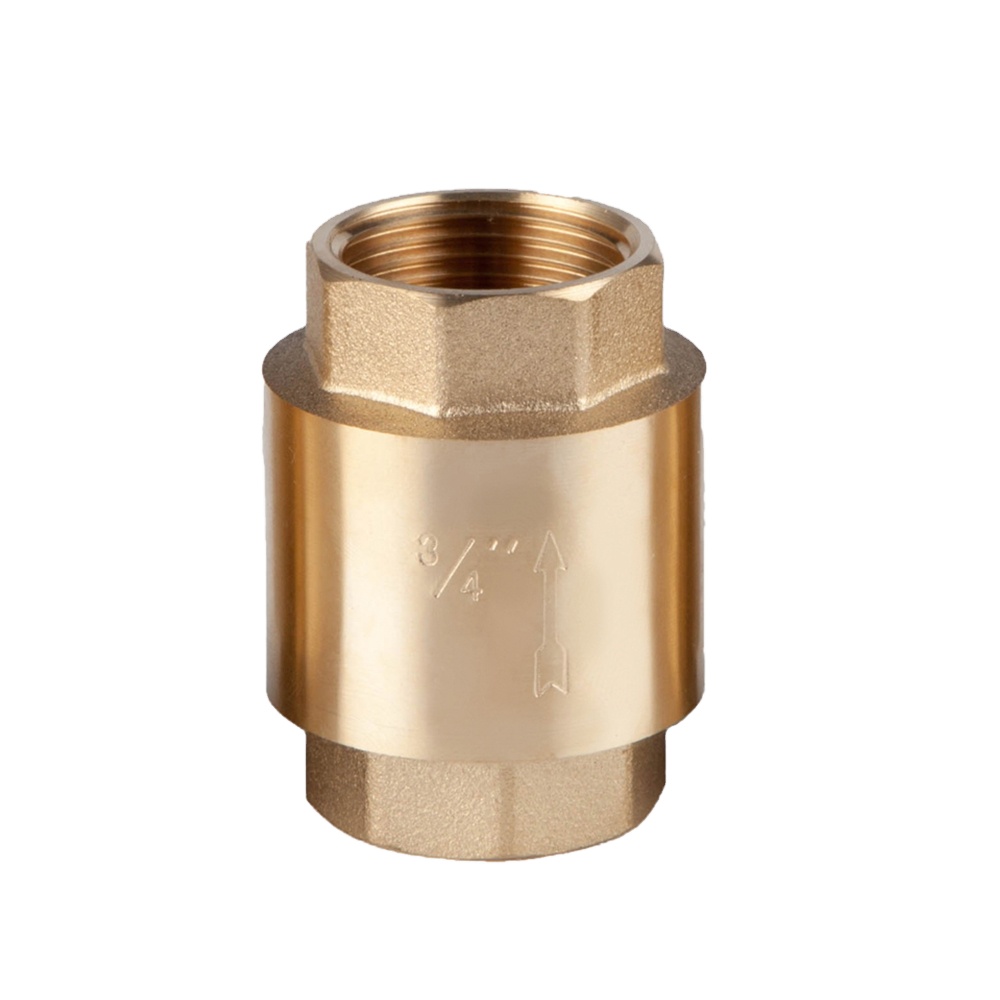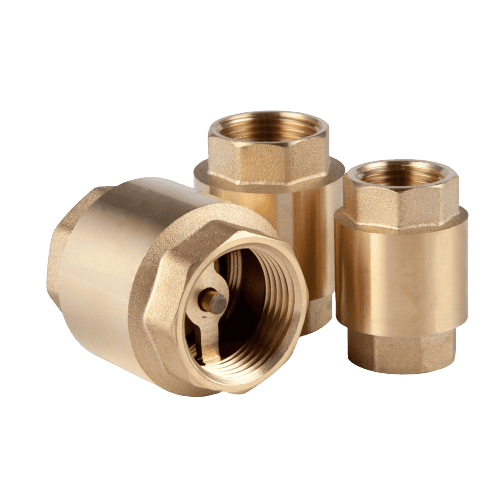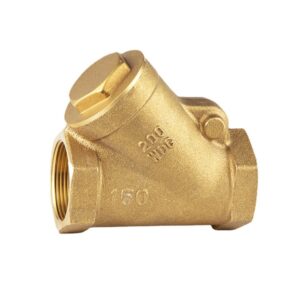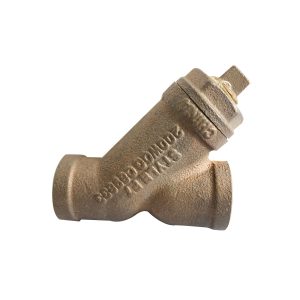Description
Water Spring Check Valve
JX-0605
- Brass Check Valve Non-Return Valves
- Size 1/2″-4″
- Materials; H58-3 brass,CW617N,DZR
- Plastic core with female thread
- Forged brass with natural color
- Pressure rated to 12 bar
- Operating temperature: -10°C to 100°C
- Thread connection : (G, Rc, RP) BSP
- Non-return check valve fully made of brass with a spring mechanism to let the water flow only one way. The check valve can last a maximum pressure of 12 bar. There is a range of sizes available. Specifications:
– Material: Brass;
– Insert material: Brass;
– Thread type: Female x Female;
– Max. Static Pressure: 1,2MPa (12 bar);
– Max. Working Temperature: +100C;
– Gasket type: NBR (flat).
The check valve relies on the flow of the media itself and automatically opens and closes the valve flap, used to prevent the media back to the valve, also known as the water check valve, counterflow valve, and back pressure valve. The check valve is automatic, and its main role is to prevent media backflow, prevent the pump and drive motor reversal, and release container media.
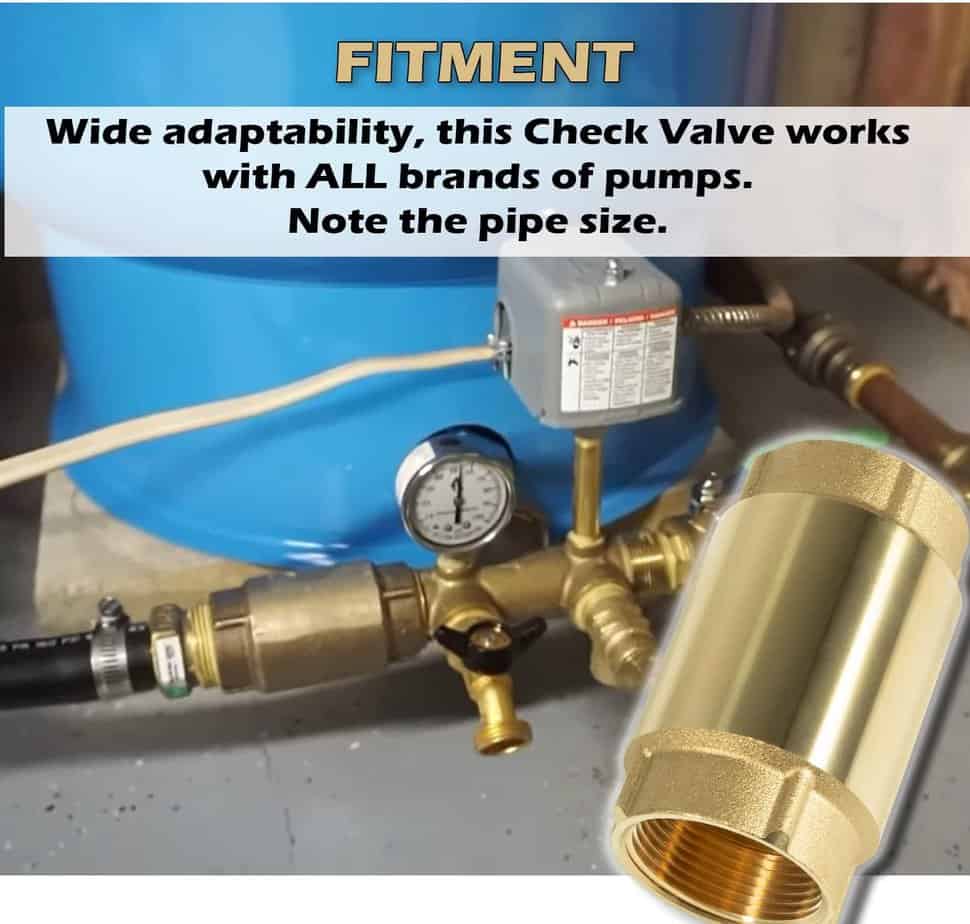 inline spring loaded check valve
inline spring loaded check valve
Check Valves for Water Lines: What Every Homeowner Should Know
Water lines in your home might seem like simple conduits for the liquid of life, but there’s more to them than meets the eye. At the heart of these systems are vital components like check valves designed to ensure water flows efficiently and safely. If you’ve ever wondered about the role of check valves in water lines, you’re in for a treat. This guide will dive deep into their functionality, importance, and how to maintain them.
Brass Check Valve Introduction
Fluid can only flow in one way through a brass Brass check valve. This stops fluid from flowing backward, which could lead to contamination or destruction of other elements. Check valves are self-contained and do not require any manual intervention. Most available variants contain a little spring to seal the valve, which is opened by applying medium push in the forward motion. It’s worth noting that the valve must be opened with a certain pressure level (usually called cracking pressure).
A check valve, sometimes a one-way or non-return valve, is an ingenious component. It allows fluid (in this case, water) to flow in one direction and prevents it from flowing backward. In doing so, it ensures consistent water pressure and prevents contamination.
Why Every Water Line Needs One
Imagine, after a day of heavy rainfall, your city’s drainage system is overwhelmed, and water flows backward into the clean water supply. Without a check valve, this contaminated water could end up in your tap. That’s the catastrophe check valves prevent.
Types of Check Valves
- Swing Check Valves: These use a swinging disc to allow or prevent flow. When water flows in the right direction, it pushes the disc open. If it tries to reverse, the disc swings shut.
- Lift Check Valves: Operate on a similar principle, but instead of swinging, they lift a disc or ball off its seat.
- Inline Check Valves: Common in household applications, these rely on a spring mechanism that opens when water flows in the correct direction.
Materials Matter
- Brass: Offers durability and excellent corrosion resistance.
- Stainless Steel: Known for its longevity and robustness against harsh conditions.
- PVC: Lightweight and cost-effective, perfect for residential uses.
The sizes of check valves for water lines;
- Residential Plumbing: In typical home plumbing, check valves can range from about 1/2 inch to 2 inches in diameter. These are ideal for household applications like sinks, toilets, and garden hoses.
- Commercial Plumbing: In commercial setups like hotels, offices, or manufacturing plants, check valves may be much larger, even up to 4 inches or more in diameter, to accommodate greater water flow.
- Industrial Applications: In heavy-duty industrial scenarios, check valves can be custom-built to larger sizes, potentially several feet in diameter, to handle high flow rates.
- Specialty Applications: Miniaturized check valves might be used for unique applications such as medical devices or specialized machinery. These could have diameters as small as a few millimeters.
The size of the check valve must be compatible with the size of the pipe it’s connecting to, ensuring a secure and leak-free fit. Always consult a plumbing professional to determine the right size for your needs.
What are the applications of Brass Check Valves?
Check valves are often utilized for one of four main reasons in a range of applications because of how they work:
· To safeguard downstream equipment from backflow damage
· To avoid pollution as a result of reverse flow
· To avoid siphoning
· To maintain a vacuum seal
They are employed in practically every industry because of their function. Kitchens, washers, dryers, and wastewater pipes are all examples of popular domestic equipment that utilize them.
They are utilized in industrial heaters, kilns, gas machines, pumping operations, and vacuum systems. They’re also commonly used as aquariums to check valves on freshwater and Carbon dioxide lines.

What is the specification of the Brass Check Valve?
Valve shape, pressure range, medium heating, and valve flow rate are all performance specifications.
When choosing a check valve, it’s critical to consider the pressure losses in the flow processing system. The flow and, as a result, pressure and flow alterations control the check valve’s performance. The intensity of the shutdown is determined by the inverse pressure drop, which occurs when downhill pressure exceeds the upstream level. This indicates that the downstream flow pushes on the closure element as the reversal pressure loss, resulting in an improved shutdown.
What factors need to consider if purchasing a check valve?
Estimating the specific system’s cost before selecting a control valve is critical. The goal is often to save money while achieving the lowest pressure loss; however, more safety equals more pressure drop related to check valves.
To ensure that the check valve effectively safeguards the system, each system must be evaluated separately, considering the risk of water hammer, tolerable pressure drops, and the economic effects of having a check valve with an excessive water hammer safety factor taken into account.
Installation Tips
- Positioning is Key: Check valves should be installed in a location easily accessible for maintenance.
- Flow Direction: Always install with the flow arrow pointing in the direction of the water flow.
- Professional Installation: While DIY is tempting, professional installation ensures optimal performance.
Maintaining Your Check Valve
- Regular Inspection: Over time, debris can accumulate and hinder the valve’s performance. Regular inspections will ensure it remains in top condition.
- Seal Checks: Ensure the valve’s seals remain intact to prevent leaks or malfunctions.
- Professional Servicing: Every few years, have a professional plumber inspect and service the valve, especially if you notice any issues.
Innovations in Check Valves
Modern check valves are not just about function but enhanced performance. Today, we’re seeing valves with advanced materials that last longer and are even equipped with sensors that can alert homeowners of malfunctions.
Why Choose Us?
When you purchase anything, you expect it to last a long time. This idea is applied to our high-pressure, elevated valves, developed and engineered to last a lifetime. They are just the market’s most durable, inline fixable valves with the shortest lifespan expense.
Our products meet industry requirements as a pioneer in heavy service and a specialist in harsh condition applications.
Check valves might seem like minor players in your home’s plumbing scheme, but their role is pivotal. By ensuring water flows in the right direction, they maintain the integrity and safety of your water supply. Investing in a good-quality check valve and maintaining it well will guarantee a steady and uncontaminated water flow in your home.
